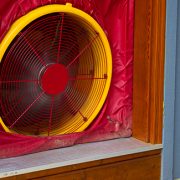What is a Air Blower Test
An air blower door test is conducted by an energy auditor to see how airtight a home is. The test is performed for several reasons, which are listed below.
- Reducing air leakage to improve energy usage
- Eliminating condensation buildup
- Determining the location of drafts
- Seeing how much more ventilation is needed for higher interior air quality
How It Works
To perform the test, the auditor will install a fan in an exterior door frame. The fan will draw air outside the house, which lowers the interior air pressure. The outside air will then enter the home through all openings and cracks. A tool called a smoke pencil is used by the auditor to find those leaks and discover how air infiltrates the home or building.
A blower door is a panel and frame designed to fit inside of a doorway flexibly. The fan runs at several different speeds, and a special gauge measures the pressure differential of the home. There are also hoses and an airflow manometer.
Blower doors come in two types, uncalibrated and calibrated. The uncalibrated type is largely ineffective because it can only help find leaks. It does not provide any data on how airtight structure is. An auditor should always use a calibrated blower door because it will accurately determine the amount of air that the fan is removing. This information will help the auditor see the leakage amount and how well air-sealing solutions are working.
Blower Test Preparation
The following steps should be taken prior to an air blower test:
- All wood-fueled fires should be put out, including the coals, before the test can be conducted. All ash should be removed from each fireplace.
- The homeowner should be prepared to walk through the house and show the auditor all of the locations that have drafts or are difficult to heat and cool effectively.
- The homeowner should be prepared to grant access to the entire home, including empty rooms, attics, closets and crawl spaces.
- Before the test, the auditor will close exterior windows and shut all of the exterior doors. The interior doors will be opened and all woodstove inlets and fireplace dampers will put in the closed position.
- The auditor will set all thermostats to ensure that furnaces and other appliances that rely on fossil fuels do not come on while the test is being run. When testing ends, they should be returned to their original settings.
- The test will take at least one hour. Larger and more complex homes could take longer.






Leave a Reply
Want to join the discussion?Feel free to contribute!